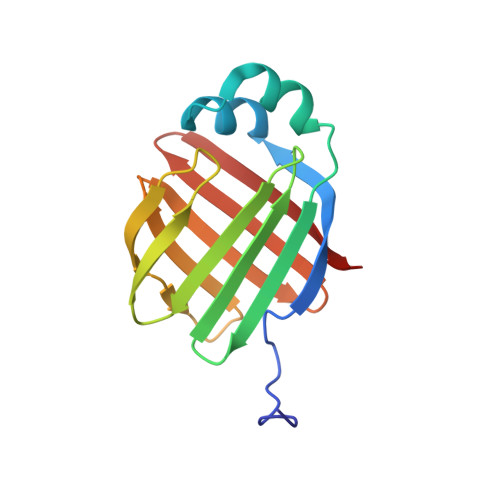A ligand-induced structural change in fatty acid-binding protein 1 is associated with potentiation of peroxisome proliferator-activated receptor alpha agonists.
Patil, R., Mohanty, B., Liu, B., Chandrashekaran, I.R., Headey, S.J., Williams, M.L., Clements, C.S., Ilyichova, O., Doak, B.C., Genissel, P., Weaver, R.J., Vuillard, L., Halls, M.L., Porter, C.J.H., Scanlon, M.J.(2019) J Biological Chem 294: 3720-3734
- PubMed: 30598509
- DOI: https://doi.org/10.1074/jbc.RA118.006848
- Primary Citation of Related Structures:
6DO6, 6DO7, 6DRG - PubMed Abstract:
Peroxisome proliferator-activated receptor α (PPARα) is a transcriptional regulator of lipid metabolism. GW7647 is a potent PPARα agonist that must reach the nucleus to activate this receptor. In cells expressing human fatty acid-binding protein 1 (FABP1), GW7647 treatment increases FABP1's nuclear localization and potentiates GW7647-mediated PPARα activation; GW7647 is less effective in cells that do not express FABP1. To elucidate the underlying mechanism, here we substituted residues in FABP1 known to dictate lipid signaling by other intracellular lipid-binding proteins. Substitutions of Lys-20 and Lys-31 to Ala in the FABP1 helical cap affected neither its nuclear localization nor PPARα activation. In contrast, Ala substitution of Lys-57, Glu-77, and Lys-96, located in the loops adjacent to the ligand-binding portal region, abolished both FABP1 nuclear localization and GW7647-induced PPARα activation but had little effect on GW7647-FABP1 binding affinity. Using solution NMR spectroscopy, we determined the WT FABP1 structure and analyzed the dynamics in the apo and GW7647-bound structures of both the WT and the K57A/E77A/K96A triple mutant. We found that GW7647 binding causes little change in the FABP1 backbone, but solvent exposes several residues in the loops around the portal region, including Lys-57, Glu-77, and Lys-96. These residues also become more solvent-exposed upon binding of FABP1 with the endogenous PPARα agonist oleic acid. Together with previous observations, our findings suggest that GW7647 binding stabilizes a FABP1 conformation that promotes its interaction with PPARα. We conclude that full PPARα agonist activity of GW7647 requires FABP1-dependent transport and nuclear localization processes.
- From Medicinal Chemistry.
Organizational Affiliation:
















